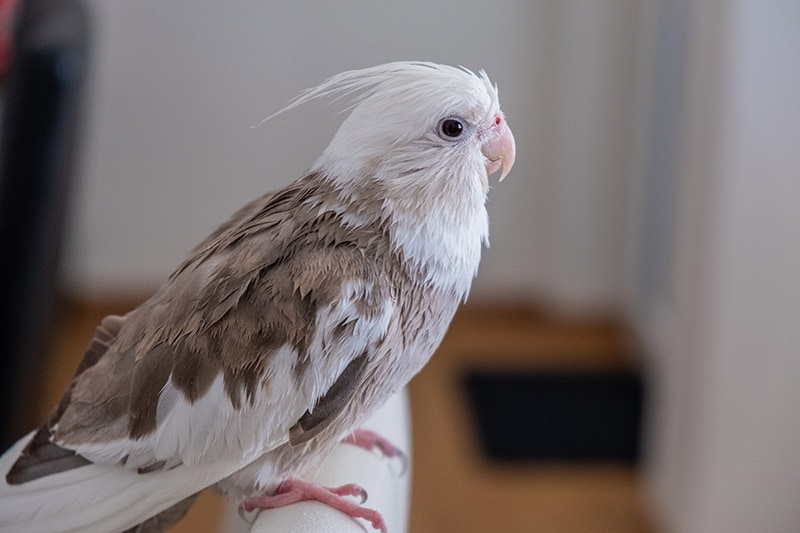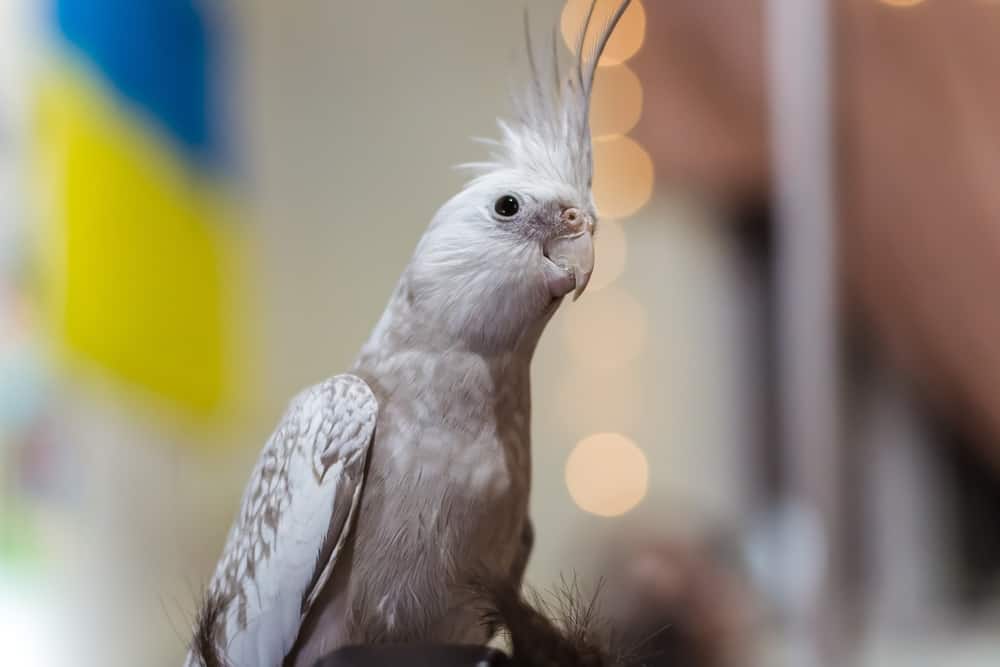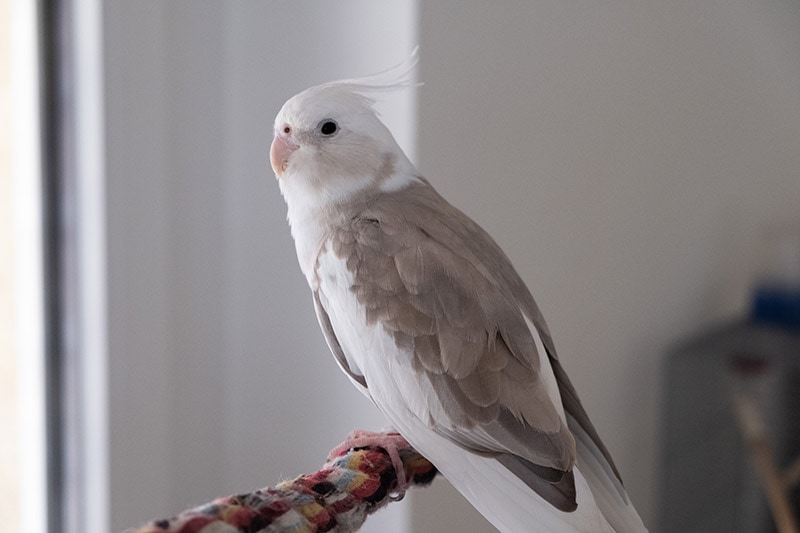White-faced Cockatiels can be very striking, standing out because they lack any yellow color and have no cheek patches!
The White-faced Cockatiel has a white or grayish face as shown above. This is a stunning cockatiel mutation, they stand out because they have no orange cheek patches or yellow coloring at all. The name of this mutation, derived from the male, is fairly self explanatory. The male is the most attractive of the two sexes with a brilliant contrasting white face. The female’s face, on the other hand, has a greyish coloration.
White-faced Cockatiels first appeared in 1964. Today they are fairly common mutations. Some very pretty Whiteface varieties are created when combined with other cockatiel mutations and each of these mixes further enhances the beauty of these pet birds. Some of the different color varieties they come in include grey, pearl, cinnamon, pied, and albino. “L.A.” in the picture above looks like a Gray White face Cockatiel, or maybe a Pied Whiteface Cockatiel.
Cockatiels are probably the most popular of the parrot family with their main competition being the Budgerigar (referred to as the Parakeet in the United States). They are hardy, easily handle changes in their home, and are easy to breed. On top of that, keeping a cockatiel as a pet is easy because they are not noisy parrots and they are comfortable when left alone for long periods of time.
Cockatiel’s evolved as nomadic creatures, surviving in a variety of diverse and rugged habitats. They are constantly on the move, changing locations with the seasonal fluctuations of food and water supplies. This native habitat and their adaptive behavior has made them well suited as pets.
- For more information about the care of Cockatiels see: Guide to a Happy, Healthy Cockatiel
Scientific Classification
| Kingdom: | Animalia |
| Phylum: | Chordata |
| Class: | Aves |
| Order: | Psittaciformes |
| Family: | Cacatuidae |
| Genus: | Nymphicus |
| Species: | hollandicus |
Scientific Name
Distribution
The white-faced cockatiels are a color variety that is not found in the wild.Grey cockatiels are found over most of Australia except the coastal areas and most of Tasmania. Tasmania, an island state of Australia, has many of the parrots found in Australia but the cockatiel is not present there. It is thought that though they are one of Australia’s fastest flyers, their flying strength is apparently not sufficient to help them bridge the waterway that separates the island from the Australian mainland.

Description
Cockatiels are considered parrots, as can be seen by the shape of their beak. Cockatiels are probably the most popular of the parrot family. They are closely related to the Cockatoos, and like Cockatoos they are members of the Cacatuidae family.
As members of the Cacatuidae family, they too have an erectile crests. This cute little crest will be held erect when they are stimulated and excited, flattened when they are feeling angry, defensive, or submissive, and somewhere in between when they are in their normal ‘hanging out’ state. Unlike the other members of this family, however, they have long tails. The tail makes up about half of their total length and gives them more of a parakeet-type appearance
The White-Faced Cockatiel is a striking mutation. This cockatiel mutation is charcoal grey in color with no orange cheek patches or yellow coloring at all. The gene that creates a White-faced Cockatiel is what is known as an autosomal recessive gene. This gene effects the lipochromes pigment, it actually stops the production of the yellow pigments. It doesn’t change the amount of pigment, just the color of it. So with no yellow or orange present, the color is replaced by white. Mature adult males will carry a white face as opposed to the yellow mask worn by other varieties.
White-faced Cockatiel Mutations: Combinations that further enhance the beauty of these pet birds, include:
- White-faced Grey Cockatiel:
The White-faced Grey has the same white stripe on outer edge of the wings as the normal Grey Cockatiel. The males will have a whiter head and the females will have more of a grayish head. The females will also have the barred markings underneath their tail feathers while the males will have none. - White-faced Pearl Cockatiel:
Like the Pearl Cockatiel, the male will loose its pearl markings with its first molt at six months. It will then look like the White-faced Grey Cockatiel. However the female will retain the pearl markings. - White-faced Pied Cockatiel:
The White-faced Pied will have a striking combination of whites and greys in a random pattern. Like the Pied Cockatiel, it is impossible to determine the sex of these cockatiels visually. - White-faced Pearl Pied Cockatiel:
White-faced Pearl Pieds will have combination of whites and greys in a random pattern and can be both dominant and reverse. Again the males will lose the pearl markings at its six month molt, and the females will retain the pearling. - White-faced Cinnamon Cockatiel:
On the White-faced Cinnamon, as on the Cinnamon Cockatiel, the grey markings are replaced with the tannish grey or cinnamon coloring - White-faced Cinnamon Pearl Cockatiel:
White-faced Cinnamon Pearls can be both dominant and reverse and will have the grey markings replaced with the cinnamon coloring. Again the males will lose the pearl markings at its six month molt, and the females will retain the pearling. - White-faced Cinnamon Pied Cockatiel:
White-faced Cinnamon Pied will have the grey marking replaced with the cinnamon coloring, have a combination of whites and cinnamons in a random pattern, and can be both dominant and reverse. - Albino Cockatiel:
The Albino Cockatiel is not a true ‘albino, but is actually a combination of a White-faced Cockatiel and a Lutino Cockatiel. The Whiteface gene removes all the yellow and orange that would be present in a Lutino and the Lutino gene removes all the black and grey. The result is an all white cockatiel with red eyes. They are impossible to sex visually, so you will need a DNA test to determine what sex your pet is.
See descriptions of sexual differences for this pet bird cockatiel below, under the breeding cockatiels section.
Size – Weight
These birds get up to 12 inches (30 cm) and weigh 3 to 4 ounces.
Care and feeding
Good sized bird cages are a must for good cockatiel care. A roomy cockatiel cage is required unless the bird is to be let out for extended periods. The cage for a cockatiel should measure a minimum of 24″ length by 18″ high and 18″ wide. This will leave enough room for several toys and still give the bird room to fully stretch his/her wings without hitting them. Many birds can spend most of their time on a playpen or parrot perch. Bird food consists of a variety of sprouts, seeds, nuts, fruits, vegetables, and commercial pellets.
- See About Cockatiels: Care and Feeding for more information.
Social Behaviors
Cockatiels travel in flocks in the wild and this influences cockatiel behavior in captivity. Their social ‘flock’ disposition along with their native habitat makes them well-suited as pets. They are hardy, adapt easily to change, and are easy to breed. A big plus is that cockatiels are not noisy and can be left alone for long periods of time. They make a very loving and devoted pet if bonded properly.
- For taming cockatiels and cockatiel training, see About Cockatiels: Handling and Training.
Activities
Common bird activities for cockatiels, they like to climb and play. Cockatiel bird care includes providing lots of bird toys and excercise. Give them plenty of time outside the cage if possible, a playpen works well for this. Many cockatiels can learn to talk and whistle, especially the males.
- See About Cockatiels: Activities for more information.
Breeding/Reproduction
Cockatiel breeding can be a very rewarding experience. Cockatiels will readily nest provided they have a nest box and some material to construct the nest from. They lay one egg every other day until they have laid about 5 eggs. The incubation period is 17 – 22 days. After hatching the young birds will open their eyes at 9 days of age.
This is a good time to start hand feeding if you don’t want to incubate the eggs yourself. Incubation and raising the chicks yourself requires dedication since the young chicks will need feedings every two hours for the first couple of weeks. Likewise, you can pull them from the nest earlier than 9 days, but with greater risk to the chick and greater effort on your part with frequent feedings. After about 18 days the orange cheek patch will appear on the babies. At about 30 days they will look like adult birds, and will fledge at about 35 days of age.
- For more information on cockatiel breeding, see About Cockatiels: Breeding/Reproduction.
Sexual differences
There are a lot of opinions about how to sex these birds but usually they are just indicators and not sure ways to tell. For White-faced cockatiels, the males will have a whiter head and the females will have more of a grayish head. The females will also have the barred markings underneath their tail feathers while the males will have none.

Potential Problems
The cockatiel health is easy to maintain as these are very hardy birds, but for all pet birds there are potential problems For optimum bird health care for your cockatiel, it is good to know what signs of illness to be aware of.
- For information about cockatiel health, see About Cockatiels: Problems.
Availability
The White-faced Cockatiel is sometimes available and the cockatiels for sale from this group can come in a lot of different varieties including grey, lutino, pearl, pied and cinnamon. The white-faced cockatiel is generally quite a bit more expensive than the regular Grey Cockatiel or Lutino Cockatiel.
Featured Image Credit: Zdenka Kincel, Shutterstock
